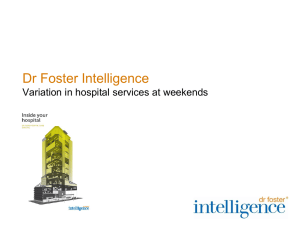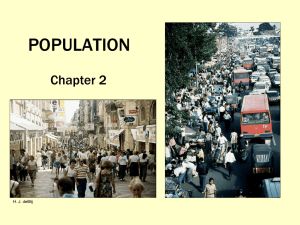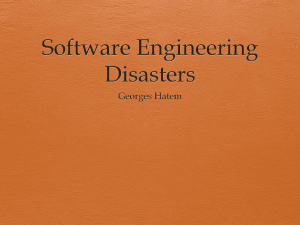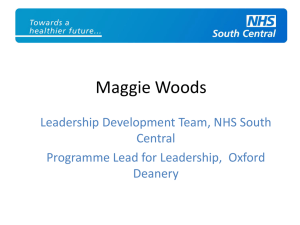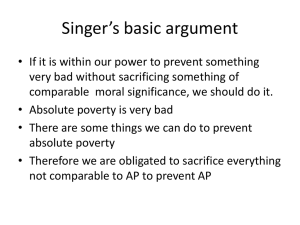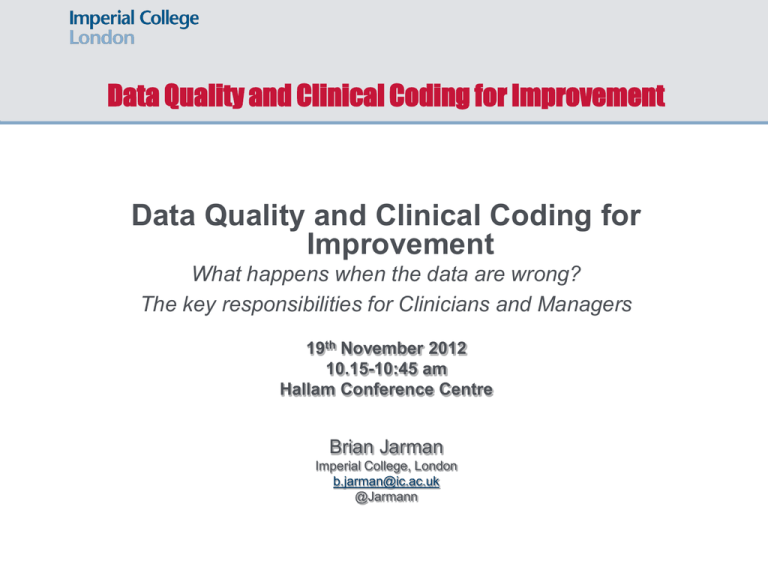
Data Quality and Clinical Coding for Improvement
Data Quality and Clinical Coding for
Improvement
What happens when the data are wrong?
The key responsibilities for Clinicians and Managers
19th November 2012
10.15-10:45 am
Hallam Conference Centre
Brian Jarman
Imperial College, London
b.jarman@ic.ac.uk
@Jarmann
Subjects I have been asked to cover
• learning from Mid Staffordshire
• clinical coding: understanding the data
and what the data is telling you
• how Dr Foster use the data to identify
outliers and produce alerts
• case studies and examples in practice
Mid Staffs Independent Inquiry, 24 Feb 2010, p366, 46
“Furthermore, the maintenance,
certification and submission of
accurately recorded data to the
regulatory authorities are ultimately the
responsibility of Trust leadership.”
Data covered
• Hospital Standardised Mortality Ratios
(HSMRs) – methodology from Dr Foster unit
(DFU) at Imperial College
• HSMR published annually from 2001 by Dr
Foster Intelligence (DFI) main national press
• Data Quality Summary – from DFI
• Monthly mortality alerts - used the Dr Foster
Unit (DFU) at Imperial College to identify
outliers and produce alerts
Variables for HSMR logistic regression adjustment
•
•
•
•
•
•
•
•
•
•
•
Age group (<1, then 5-year bands to 90+)
Sex
Admission method/type (emergency, elective etc)
Admission source (home, transfers etc)
Deprivation quintile (based on postcode)
Diagnosis subgroup (CCS sub-groups within each CCS group)
Comorbidity (Charlson score)
Emergency admissions in previous 12 months
Palliative care (any episode that has a treatment function code 315 or
any Z515 ICD10 diagnosis code)
Month of admission
Year of discharge
(Day cases are excluded from the risk models ~ 70 deaths/year)
•
http://www.drfosterintelligence.co.uk/newsPublications/HSMRMethodology.asp
Data Quality Summary – DFU monthly checks on reords:
Duplicate record
Consultant
Admission/Appointment date
Ethnicity
Episode order
Elective/Referral date
Admission method/Appointment type
Discharge/Outcome
Sex
Diagnosis
Date of birth
Procedure
Provider
Procedure date
Episode start
Spell overlaps
Episode end
Missing first episode
Episode duration
Missing last episode
Postcode
Inconsistent bed-days/LOS
NHS Number
Age group
GP Practice
Sex (spell)
Local patient ID
Admission (spell)
Age
Episode order (spell)
Day case
Invalid LOS
Deprivation
Invalid HRG
Provider + Local patient ID
Effect of coding of variables in model
•
•
•
•
•
Direct vs indirect standardisation
Comorbidity (Charlson Index)
Palliative care
Admission vs patient
All in-hospital deaths vs 30-days inhospital deaths
• HSMR covering 80% deaths (56 CCS)
vs HSMR all IP deaths (259 CCS gps)
Comparison of indirect vs direct standardisation 2005
HSMR (simple model)
150%
140%
Trusts
130%
Indirectly standardised HSMR
Identical match
25% more than
directly standardised
10% more than
directly standardised
10% less than
directly standardised
25% less directly
standardised
120%
110%
100%
90%
80%
70%
60%
60%
70%
80%
90%
100%
110%
Directly standardised HSMR
120%
130%
140%
150%
Charlson co-morbidity index
150
Comparison of HSMR calculated
with and without Charlson
English Acute Trusts 2008/9
140
y = 0.9043x + 9.6201
R² = 0.8918
130
HSMR without Charlson
Trusts
120
Identical match
25% more than standard HSMR
110
10% more than standard HSMR
100
10% less than standard HSMR
Salford Royal NHS
Foundation Trust
90
25% less than standard HSMR
80
70
60
50
50
60
70
80
90
100
HSMR
110
120
130
140
150
Palliative care
150
Comparison of HSMR calculated
using adjustment or exclusion
to account for palliative care
English Acute Trusts 2008/9
y = 1.0367x - 3.4837
R² = 0.9001
140
130
HSMR excluding paliative care
Trusts
120
Identical match
25% more than standard HSMR
110
10% more than standard HSMR
100
10% less than standard HSMR
25% less than standard HSMR
90
80
Medway NHS Trust
70
Walsall Hospitals NHS Trust
60
50
50
60
70
80
90
100
110
120
130
140
HSMR adjusting for palliative care
150
Admissions versus Patients
150
Comparison of HSMR calculated
using admissions and based on
last admission in financial year
English Acute Trusts 2008/9
140
y = 0.8741x + 12.626
R² = 0.9182
HSMR based on last admission in financial year
130
Trusts
120
Identical match
25% more than standard HSMR
110
10% more than standard HSMR
100
10% less than standard HSMR
25% less than standard HSMR
90
Trafford Healthcare NHS Trust
80
70
60
50
50
60
70
80
90
100
HSMR
110
120
130
140
150
HSMR (all in-hospital deaths) vs. all in-hospital 30 day deaths
150
140
Comparison of HSMR calculated
using 30 day in-hospital deaths
with HSMR using all in-hospital eaths
English Acute Trusts 2008/9
y = 0.9774x + 1.7673
R² = 0.9941
130
HSMR in-hospital 30 day deaths
Trusts
Identical match
120
25% more than in-hospital deaths HSMR
10% more than in-hospital deaths HSMR
110
10% less than in-hospital deaths HSMR
25% less than in-hospital deaths HSMR
100
Linear (Trusts)
90
80
70
60
60
70
80
90
100
110
120
130
HSMR (all in-hospital deaths)
140
150
HSMR 30 day in-hospital deaths vs 30 day all deaths
150
140
Comparison of HSMR calculated
using 30 day in-hospital deaths
with HSMR using all 30 day deaths
English Acute Trusts 2004/5
y = 0.8756x + 12.671
R² = 0.9219
130
HSMR all 30 day deaths
Trusts
120
Identical match
25% more than in-hospital deaths HSMR
Bradford Teaching
Hospitals NHS
Foundation Trust
110
10% more than in-hospital deaths HSMR
100
10% less than in-hospital deaths HSMR
25% less than in-hospital deaths HSMR
90
80
70
60
50
50
70
90
110
130
HSMR in-hospital 30 day deaths
150
56 diagnosis group HSMR vs. all 259 CCS diagnoses
150
Comparison of HSMR calculated
using 56 diagnoses compared with all 259
diagnoses English Acute Trusts 2008/9
140
HSMR based on all diagnosis groups
130
y = 0.9743x + 2.2451
R² = 0.9666
Trusts
Identical match
120
25% more than standard HSMR
10% more than standard HSMR
110
10% less than standard HSMR
25% less than standard HSMR
100
Linear (Trusts)
90
80
70
60
60
70
80
90
100
HSMR
110
120
130
140
150
The changes of palliative care coding by CfH rules.
Changes at Medway, Mid Staffs and Basildon = effect on HSMRs
• March 2007 - Medway
• From March 2007 CfH Coding Clinic permitted ‘non-curable’ illnesses to be coded as
palliative care secondary diagnosis Z51.5 (not just terminal illnesses under consultant)
• Imperial College was persuaded to introduce a palliative care adjustment
• Medway increased % deaths coded Z51.5 from <1% to 37% and HSMR value
decreased (advised by CHKS). Only trust in England at that time to make those changes
• CHKS, Dec 2008: “Our review of coding at Medway NHS Foundation Trust found that
end-of-life care was recorded for only eight per cent of deaths, when the actual
proportion should have been 37 per cent. We believe that the hospital mortality index
should exclude these cases and, by making this adjustment, Medway's mortality index
reduced by just over a third.”
• March 2008 - Mid Staffs
• Mid Staffs made similar changes and HSMR reduced by ~7%
• Two other West Midlands SHA trusts made similar changes later in 2008
• We publicised the effect of Z51.5 changes on HSMR values (‘doesn’t save lives’)
• Mid 2009 - Basildon & Thurrock
• Made similar changes to starting mid 2009
• June 2010 – CfH Coding Clinic reverted to ~pre 2007
Changes in coding at Medway, Mid Staffs and Basildon
• Mid Staffs and Basildon
• In 2005/06 had the highest HSMR (lower 95% CI above 100)
• In 2007 had the largest number of mortality alerts from
Imperial College
• Had had significantly high HSMRs for about 10 years
• First major palliative care coding change was
at Medway NHS Foundation Trust in 2007 was advised would reduce its HSMR value.
CHKS 11 Dec 2008 press release re HSJ article (exh BJ87)
Medway coding of palliative care vs HSMR
60%
160
MEDWAY HSMR
140
120
England % deaths coded
as palliative care
40%
30%
80
MEDWAY
%deaths Z51.5
20%
ENGLAND
% deaths Z51.5
60
Medway NHS
Foundation Trust (RPA)
% deaths coded as
palliative care
40
HSMR Medway NHS
Foundation Trust
10%
20
0%
HSMR
100
2004-Q2
2004-Q3
2004-Q4
2005-Q1
2005-Q2
2005-Q3
2005-Q4
2006-Q1
2006-Q2
2006-Q3
2006-Q4
2007-Q1
2007-Q2
2007-Q3
2007-Q4
2008-Q1
2008-Q2
2008-Q3
2008-Q4
2009-Q1
2009-Q2
2009-Q3
2009-Q4
2010-Q1
2010-Q2
2010-Q3
2010-Q4
2011-Q1
2011-Q2
2011-Q3
2011-Q4
2012-Q1
% deaths coded as palliative care
50%
0
Happenings re Mid Staffs in February & March 2008
• 1 Feb 2008 Mid Staffs was formally awarded
Foundation Trust status by Monitor
• 1 Feb 2008 A group of local patients told the local
PCT about complaints from patients that had come to
the HCC independently through its helpline
• 14 Feb 2008 Healthcare Commission Investigations
Committee met to discuss concerns about the Trust
• 15 Feb 2008 Mid Staffs increased the % cases
coded as palliative care and coder started coding all
deaths herself. Large increase % deaths coded
palliative care Z51.5 from March 2008.
• 18 March 2008 Healthcare Commission investigation
Healthcare Commission investigation at Mid Staffordshire NHS
Foundation Trust - press release 18 March 2008
Healthcare Commission press release 18/3/08
• “The Healthcare Commission has also recently
received a number of concerns from individual
patients and relatives, about standards of care at
ward level.”
• “The Healthcare Commission is therefore launching
an investigation at Mid Staffordshire NHS Foundation
Trust.”
• “The trust’s data on outcomes for patients has also
recently caused the Dr Foster Unit at Imperial
College London to bring concerns to the attention of
the trust and the Healthcare Commission.”
5%
20
0%
0
2004-Q2
2004-Q3
2004-Q4
2005-Q1
2005-Q2
2005-Q3
2005-Q4
2006-Q1
2006-Q2
2006-Q3
2006-Q4
2007-Q1
2007-Q2
2007-Q3
2007-Q4
2008-Q1
2008-Q2
2008-Q3
2008-Q4
2009-Q1
2009-Q2
2009-Q3
2009-Q4
2010-Q1
2010-Q2
2010-Q3
2010-Q4
2011-Q1
2011-Q2
2011-Q3
2011-Q4
2012-Q1
% deaths coded as palliative care
40%
160
35%
140
30%
120
25%
100
20%
80
15%
60
10%
40
HSMR
Mid Staffs coding of palliative care vs HSMR
England % deaths
coded as palliative
care
Mid Staffordshire
NHS Foundation
Trust (RJD) %
deaths coded as
palliative care
HSMR Mid
Staffordshire NHS
Foundation Trust
37. Mid Staffordshire NHS Hospitals Trust HSMRs – follow-up after
mortality reduction programme (as at 16 Dec 2010)
Healthcare Commission
first report 18/03/2008
John Holden, Director of system regulation Department of Health; former head of
foundation trust team. Mid Staffs Public Inquiry 14-Sep2011, Exhibit JH6
DH email 04/03/2009 “Subject: Re: Mid staffs lines to take etc”
• During the period of SHA and DH assessment (ie up
to SoS support) the first Dr Foster report had only
just been published, April 2007). The SHA had set in
place a process for the findings to be validated and
supported the trust in developing an action plan. At
this time, the issue was thought to be largely one of
clinical coding. It was only after further Dr Foster
reports were published, from July2007, focusing on
specific patient groups was it recognised (including
by HCC) that there was potentially greater cause for
concern. Even so the HCC did not launch its
investigation until March 2008.
John Holden email 09 March 2009 exhibit JH9
DH email 09/03/2009: “Subject Urgent-Mid Staffs.”
• "Miranda, further to our discussion, the Secretary of State is
tomorrow briefing the Cabinet on the issues arising at Mid
Staffs. The key issue being considered is how regulation is
working in the NHS, and whether the difficulties at Mid Staffs
are evidence that more needs to be done. In order to brief
Secretary of State we need to establish the extent to which
standardised mortality rates feature in Monitor’s compliance
regime and application assessment process.…
• “Looking at Monitor’s Board Minutes for January 2008 re
consideration of Mid Staffs, it is noted that “the Trust received a
127 mortality rate for2005/06 from Dr Foster. This has reduced
to c. 101 between May and August 2007/08 as a result of
significant improvements to coding for co-morbidities;” ”
• This figure ‘101’ is incorrect (exhibit BJ83). The HSMR at Mid
Staffs May-Aug 2008 = 108.7 (96.0-122.6)
Mid Staffs Public Inquiry, 20-Sep-2011
PROFESSOR SIR BRUCE KEOGH, NHS Medical Director, Department of Health
from November 2007
• DH briefing to Minister on ‘Mid staffs lines to
take etc’ Exhibits BK49, JH6
• "In April 2007, the Dr Foster’s Good Hospital
Guide classified the Trust as
having a High Hospital Standardised
Mortality Rate. (The Good Hospital
Guide was first published in 2001)“
• [DH witnesses to Mid Staffs Public Inquiry
said HSMRs were only available from 2007]
HEALTHCARE COMMISSION, INVESTIGATION INTO MID STAFFORDSHIRE
NHS FOUNDATION TRUST, 18 MARCH 2009
“The trust assumed that the raised
mortality was primarily due to poor
coding of information, but could not
substantiate its claim. .. The default
position appeared to be that the deaths
had been inevitable and there were no
problems with the care of the patients.”
Mid Staffs Public Inquiry oral evidence
• observed minus expected deaths
2005/6 - 2007/8 was not 400-1200
• Approx 500, range 400 to 600, over 3 years, 95% Conf Ints
• Exact 492, range 391-595, over 3 years, 95% Conf Intervals
•
•
•
•
2023 mentions of ‘mortality’
1018 mentions of ‘HSMR’
458 mentions of ‘hindsight’
799 mentions of ‘coding’
Some of the problems at Mid Staffordshire.
Professor Sir George Alberti. 29 April 2009
• Understaffing of A&E - too few consultants, middle-grade doctors and nurses
• Initial patient assessment by untrained receptionists
• Poor supervision of junior doctors
• Weak leadership of nurses and inadequate nurse training
• Poor equipment in A&E
• Long delays and tendency to move patients to the Emergency Assessment Unit (EAU),
Clinical Decision Unit (CDU) and “assess and treat” area in order to meet the 4 hour
target before they had been investigated or any diagnosis made
• Lack of protocols and clear pathways
• Chaotic, large, understaffed EAU with little training for the nurses
• Poorly equipped EAU.
• Poor handover from EAU to medical and surgical wards
• Insufficient beds for coronary care or strokes
• Major delays for emergency operations
• Inadequate numbers of experienced surgeons with poor 24/7 cover
• Poor post-operative care
• Very poor patient care on the medical and surgical wards
• Inadequate handling of patient complaints
Healthcare Commission report on Mid Staffordshire NHS Hospitals
Trust 18 March 2009 http://www.rcn.org.uk/__data/assets/pdf_file/0004/234976/Healthcare_Commission_report.pdf
“The SHA was not aware of any
concerns regarding the quality of
services provided by the trust before Dr
Foster Intelligence published its
Hospital Guide in April 2007.”
[Note: HSMRs published annually in the Dr Foster Good
Hospital Guide had shown Mid Staffs to have significantly high
HSMRs for 9 years before 2007/8.
Mortality alerts were sent by Imperial College to the hospital
and the Care Quality Commission from July 2008]
Mid Staffs Public Inquiry 26-Sep-2011
Sir Hugh Taylor's statement, ex-Permanent Secretary, DH, Statement
Paragraph 54:
• "In terms of the role of the SHA in
relation to the situation at the Trust, at
the time of publication of the report, my
view is that it probably became too
defensive, having been drawn too far
into the issue of poor coding rather than
seeing the mortality information as a
basis for further investigation."
Bill Moyes, ex-Chair Monitor
Evidence to the HoC Health Select Committee, 5 March 2009
• "We also relied on the extensive work
that had been done by the trust itself to
try and understand its high mortality
rates. It was not that we did not know
about them, but we were persuaded by
the external scrutiny of SHAs, by the
work that the SHA did, by the PCT's
view that this was a coding problem and
not an indicator of really seriously
deficient care."
Mid Staffs Public Inquiry 20-Sep-11
PROFESSOR SIR BRUCE KEOGH, NHS Medical Director, Department of Health
from November 2007
• The trust..."had little focus on outcomes
before the publication [of the HSMRs]
..." It considered that poor coding was a
likely explanation.'
Mid Staffs Public Inquiry, 2-Mar-11
DR PHILIP COATES, Consultant physician at Mid Staffs Trust from 1996,
NICE guideline and Clinical Governance lead
Q. We'll come on to this in a little more detail later, but
you, I think, are fairly frank in your statement in
saying that it was wrong to latch on to this coding
explanation, rather than fully exploring whether there
were clinical deficiencies.
A. It was -- it was absolutely wrong to focus on it as a
sole cause for the abnormal HSMR, and it was only
much later that we began to realise that we had -- we
should be looking at clinical quality.
Q. Was Monitor wrong to accept what you were saying?
A. I would have to say yes.
Mid Staffs Public Inquiry
Dr Suarez, Medical Director Mid Staffs, statement, Paragraph 122
• "CKS [sic] offered to look at our data to
see if they could demonstrate the same
high mortality figures that Dr Fosters
did; however they could not. CKS
identified that there were coding issues,
but I believe they were very reassuring
in that they said we did not have a
problem with mortality."
Telegraph publication 24 April 2007 showed Mid Staffs HSMR
significantly high
• The Department of Health asked for the following
statement from them to go at the end of the
publication: “We would strongly advise against
patients using these figures to make decisions about
the relative safety of hospitals.”
• Inquiry Counsel oral Closing Submission 9
December 2011: "What of the HSMR statistics
published in April 2007? Why, we ask rhetorically,
wasn't more attention paid to them? “
• May 2007 University of Birmingham review of
Imperial College methodology commissioned by
West Midlands SHA.
Mid Staffs Independent Inquiry, 24 Feb 2010.
Harvard external experts’ opinion (endorsed in Inquiry report)
• "… the University of Birmingham
reports, though probably wellintentioned, were distractions. They
used the Mid Staffordshire issue as a
context for discrediting the Dr. Foster
methodology.”
• “…the [HSMR] rates published in the
Good Hospital Guide alone obviously
required extremely serious
consideration,…”
Mid Staffs Independent Inquiry, published 24 Feb 2010, pp 336 and 446
Section G Mortality statistics – Harvard independent experts’ opinion
• “We also agree that every statistical quality
monitoring algorithm, including Dr Foster,
should be critically examined by experts to
determine its validity. However, we believe
that in the case of Mid-Staffordshire, there
were so many different warning flags from
different entities, using different approaches,
and over multiple time periods, that it would
have been completely irresponsible not to
aggressively investigate further.”
Sir Bruce Keogh, Medical Director of the NHS in England, statement
to the Mid Staffs Public Inquiry, para 219:
• "I am reasonably confident that the
process which is now in place would
have picked up the situation at the trust
before it was granted Foundation Trust
status. The HSMR information and the
question in the staff survey about
whether the member of staff would be
happy for someone in their family to be
treated at the hospital are two
examples..."
Criticisms of HSMRs – ‘ranking’ and ‘league tables’
• Sir Bruce Keogh statement para 139:
•
“I have major reservations with the presentation of simplistic
‘league tables’ of HSMRs (such as those presented in the
2007 Dr Foster Hospital Guide)”
• Professor David Spiegelhalter [MSInq D135/P88/15]
• "I had considerable misgivings about Dr Foster's work for the
Good Hospital Guide, particularly their insistence on ranking
hospitals and their use of HSMR."
• The HSMRs were in fact published in 2007, (as Sir
Bruce Keogh suggested that they should be in
paragraph 133 of his statement), in alphabetical
order in three bands, 'low', 'average' and 'high'.
INQUIRY REPORT PRESENTATION TO SoS BY ROBERT FRANCIS, QC
http://www.midstaffsinquiry.com/assets/docs/Report-presentation-by-Robert-Francis-QC.doc
• Finally and perhaps of most concern, I found a widespread
culture of denial.
• The then Board’s reaction to the HCC report was individually
and collectively one of denial. It should have been one of
searching self-criticism.
• The high HMSR at Mid Staffs, however provided compelling
grounds for an investigation of the type carried out by the HCC.
• It became apparent throughout the inquiry that many staff
during the period under investigation did express concern about
the standard of care being provided to patients. The tragedy
was that they were ignored.
• The staff evidence persuaded me that a culture of bullying and
fear was prevalent in the Trust among staff. I heard of a fear of
bullying being a possible explanation for more staff not coming
forward with concerns.
• What this investigation has uncovered is a scale of failure which
I believe to be greater than that revealed by the HCC report.
Monthly mortality alerts
•
•
•
•
•
NHS hospital trusts are sent a confidential letter when an alert occurs
on a series of statistical process control charts (cumulative sum
analysis, CUSUM) that are run each month designed to detect a
doubling, over the preceding 3 months, of the odds of death for a
number of diagnosis and procedure groups that cover all IP deaths in
England. Alerts are filtered to include only signals with a probability of
a false alarm less than 0.1% and other restrictions are also applied to
exclude some diagnoses including cancer, and vague symptoms and
signs. Diagnostic procedures such as endoscopies are also excluded.
The mortality alerts are copied to the Care Quality Commission
(before 01 April 2009 to the Healthcare Commission)
First alerts sent to a trust in May 2007
Excluding ‘other’ diagnoses and cancer we currently use 43
diagnoses, 79 procedures for the alerts
Our letter to the CE of a Trust notes that alerts could be due to:
• Poor coding
• Inadequate case-mix adjustment
• Quality of care
Monthly alerts sent to hospitals: Example diagnosis = Acute MI
Anonymised version of a monthly alert letter
Sent to trust Chief Executive (copied to the CQC)
Imperial DFU (& HCC) Mortality alerts Jul to Nov 2007
• Operations on jejunum
• Aortic, peripheral and visceral artery
aneurysms
• Peritonitis and intestinal abscess
• Other circulatory disease
HCC alerts
• Diabetes (HCC)
• Epilepsy and convulsions (HCC)
• Repair abdominal aortic aneurysm (HCC)
Mortality alert from Imperial College to CE Mid Staffs 29 June 2007
Royal College of Surgeons ‘invited review’ of Mid Staffs surgical
department 2007 & 2009 (Ch 18 Closing Submission 2/12/11]
• The Royal College of Surgeons
conducted two invited reviews of the
Trust, one in 2007 and one in 2009.
• The review team was asked to advise
whether the complication rate following
colorectal surgery was acceptable and
whether any change of practice needed
to be adopted.
Royal College of Surgeons ‘invited review’ of Mid Staffs surgical
department 2007 & 2009 (Ch 18 Closing Submission 2/12/11]
• There was reference within the [2009] report to the
Trust providing care that was "grossly negligent".
• Notwithstanding the seriousness of that finding Mr
Black gave evidence that in line with usual practice
the College did not report it to the GMC.
• The Case Review Report refers to so many badly
managed cases that it would be difficult to single out
any particular surgeon.
• The review team found that the service provided by
the general surgical unit was inadequate, unsafe and
at times, dangerous.
Royal College of Surgeons ‘invited review’ of Mid Staffs surgical
department 2007 & 2009 (Ch 18 Closing Submission 2/12/11]
• Mr Black was asked about the College’s failure to follow
up the recommendations in his oral evidence:
• Q. How did you follow up that the trust had acted upon the
recommendations that the reviewers made?
• A. I believe we wrote to them, and we never subsequently
made sure that the recommendations had been carried
out.
• Q. Do you recognise that for a member of the public
listening to that, that is to say unacceptable, to put it
mildly?
• A. I would accept that. The strong recommendations were
made to the trust. The college has no statutory power to
enforce those recommendations. We did follow up by
letter. We did not follow it up any more than that, and I
wish we had done.
Richard Hamblin, Director of Intelligence CQC, Slide 58 of PPT
Institute of Health Economics 9 April 2010 as example of CQC alert
Imperial College alert for ‘complications of surgical procedures or
medical care’ we sent to the Healthcare Commission on 31/08/2007
The CQC website - Mortality outliers programme – example (accessed 16/04/2010):http://www.cqc.org.uk/_db/_documents/CQC_mortality_outliers_programme[1].doc
“Our data is therefore more specific and more timely than HSMR.”
Imperial College alert for ‘Excision of the lung ’ we sent to the
Healthcare Commission on 17/01/2009
HCC: “Following up mortality 'outliers‘, Dec 2008
• “We have established a new programme of work to
identify and follow up concerns about apparently high
rates of mortality in the NHS. Over the 12 month
period considered by this report, we have considered
85 alerts, relating to 56 acute trusts (one out of three
acute trusts in England).
• After analysing the data, we concluded that 42 of
these alerts (relating to 29 – or 17% – of acute trusts
in England), needed to be pursued by the
Commission.”
• “There is clear evidence that our follow-up action has
led directly to improvements in clinical practice, and
in the use of clinical data in NHS trusts. We expect
this to have led to direct improvements in the care
provided to patients, but acknowledge that further
evaluation is necessary to understand the extent to
which this may have happened.”
50. Example for Royal Bolton: #nof Apr 2004 – Aug 2008 (1899
admissions)
Intervention – reduce adm to op time & appoint orthopaedic geriatrician
2010-Q3
2010-Q2
2010-Q1
2009-Q4
2009-Q3
2009-Q2
2009-Q1
2008-Q4
2008-Q3
2008-Q2
2008-Q1
2007-Q4
2007-Q3
2007-Q2
25%
2007-Q1
2006-Q4
2006-Q3
2006-Q2
2006-Q1
2005-Q4
2005-Q3
2005-Q2
2005-Q1
2004-Q4
2004-Q3
Crude death rate
51. Royal Bolton: fractured neck of femur Apr 2004 – Jul 2010
Reduction of crude death rate after intervention
Intervention
30%
Crude death rate
20%
15%
10%
5%
0%
52. Royal Bolton: #nof Apr 2004 – Jul 2010
Cumulative sum of actual deaths – expected deaths if 2004-Q3 SMR had persisted
Intervention
-20
Cusum of Observed
-Expected deaths if
2004-Q3 SMR had
persisted
-40
-60
-80
-100
-120
-140
-160
-180
2010-Q3
2010-Q2
2010-Q1
2009-Q4
2009-Q3
2009-Q2
2009-Q1
2008-Q4
2008-Q3
2008-Q2
2008-Q1
2007-Q4
2007-Q3
2007-Q2
2007-Q1
2006-Q4
2006-Q3
2006-Q2
2006-Q1
2005-Q4
2005-Q3
2005-Q2
2005-Q1
2004-Q4
-200
2004-Q3
Cumulative sum obs - exp deaths
0
53. Change of length of stay (leads to reduced costs
% LoS values > 75th %ile for England (for #nof)
Long LoS = % LoS values greater than 75th percentile patient in England for #nof
35
Linear (Long LoS = % LoS values greater than 75th percentile patient in England for #nof)
30
25
20
15
10
5
0
2004-Q2
2004-Q3
2004-Q4
2005-Q1
2005-Q2
2005-Q3
2005-Q4
2006-Q1
2006-Q2
2006-Q3
2006-Q4
2007-Q1
2007-Q2
2007-Q3
2007-Q4
2008-Q1
2008-Q2
2008-Q3
2008-Q4
2009-Q1
2009-Q2
2009-Q3
2009-Q4
2010-Q1
2010-Q2
2010-Q3
% LoS values > 75th %ile for England (for #nof)
Intervention
Fig 3 Hospital standardised mortality rates (HSMR) in acute hospitals in England, 2007-8,
and change in position of North West London Hospitals NHS Trust (NWLH)
Robb, E. et al. BMJ 2010;340:c1234
Copyright ©2010 BMJ Publishing Group Ltd.
‘Hero of the Hudson’ Capt. Chesley Sullenberger’s
• “From 1967 to 1976, the chances of
dying in a large U.S. jetliner crash were
roughly 1 in 2 million. Today it’s closer
to 1 in 20 million – thanks to tightened
safety standards and a massive culture
change in the industry...”
‘Hero of the Hudson’ Capt. Chesley Sullenberger’s
• “We still think of these [patient deaths] as an
unavoidable consequence of providing care –
and sometimes that’s true, but not always,”
Sullenberger said. “We must stop thinking
about them as unavoidable and start thinking
about them as unthinkable.”
• www.ucsf.edu/news/2012/11/13085/herohudson-applies-lessons-aviation-improvepatient-safety
Paediatric cardiac surgical mortality in England after Bristol: BMJ 2004; 329 : 7 October 2004
Paediatric cardiac surgical mortality in England after Bristol: BMJ 2004; 329 : 7 October 2004
External inspection
Intervention
Paediatric Cardiac Surgery in England age 0-5
• From 1991/95 to 1999/02 PCS mortality
at Bristol reduced from 29% to 3.5% ie
8 times
• From 1991/95 to 2008/12 PCS mortality
in England reduced from 12% to 2% ie
6 times
• From 1967 to 1976, mortality in large
U.S. jetliner crashes reduced from 1 in
2 million to 1 in 20 million i.e. 10 times.
Nobel prizes vs chocolate consumption - correlation


